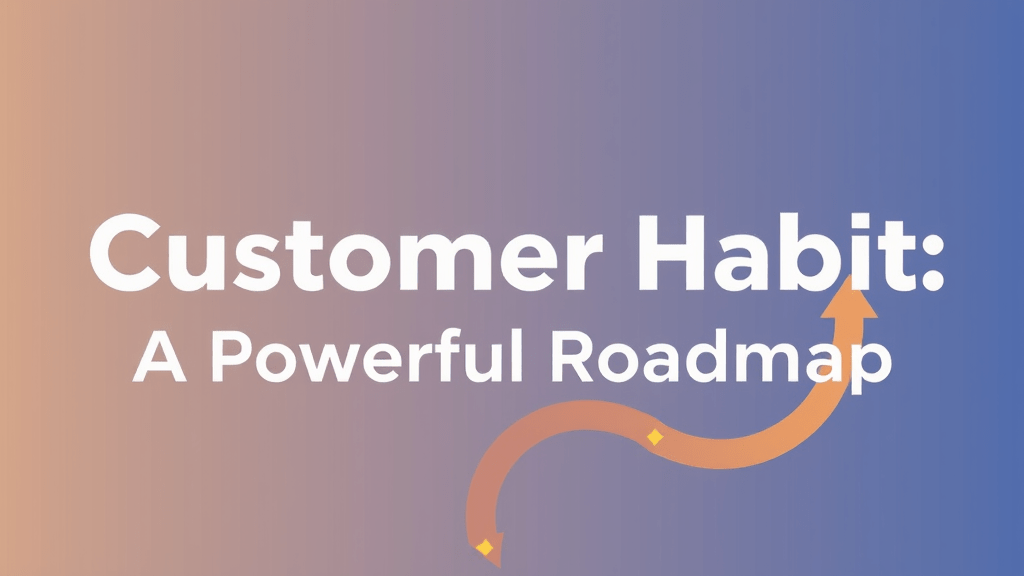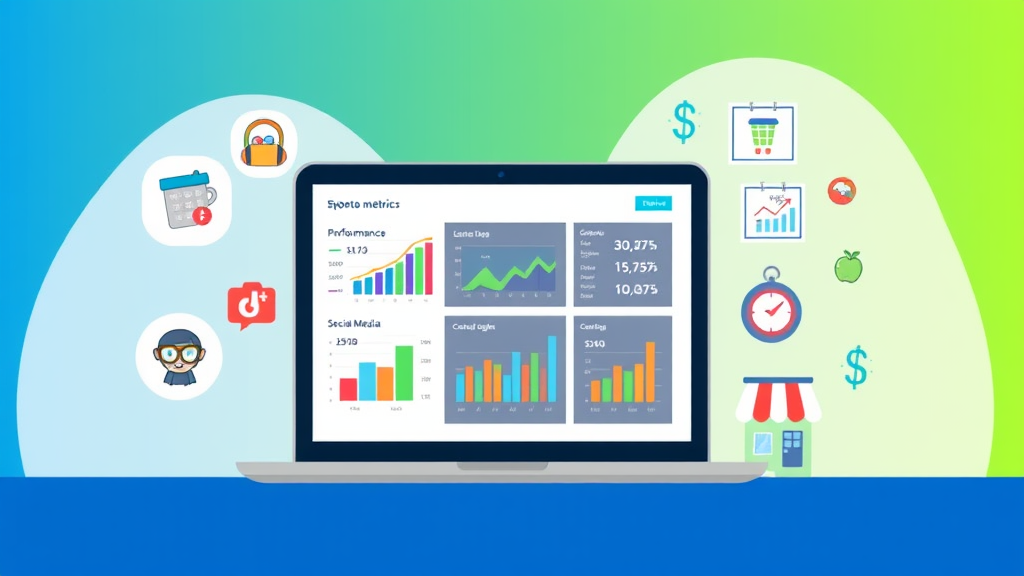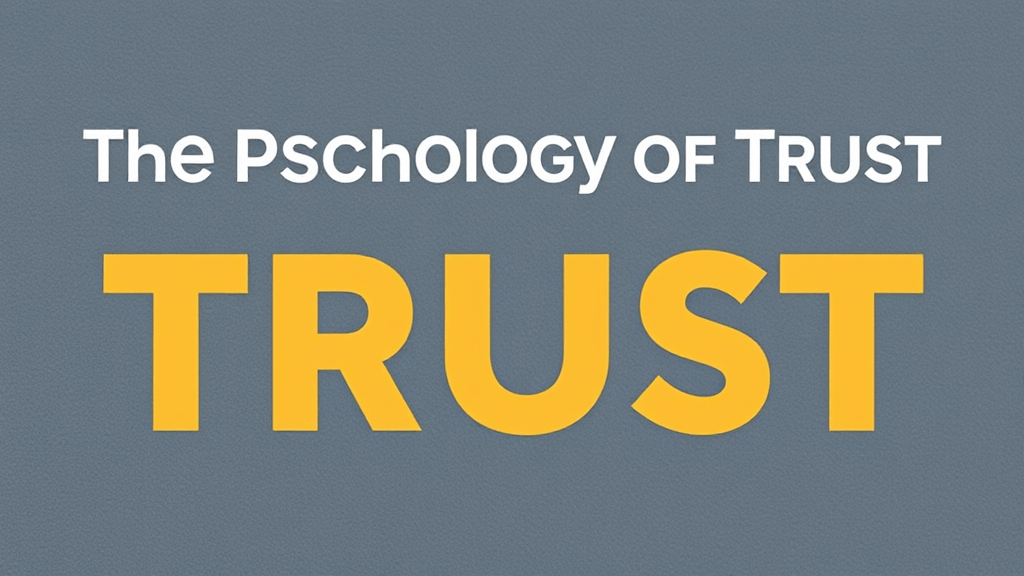The e-commerce landscape is more competitive than ever, with businesses vying for consumer attention in a crowded digital marketplace. Effective e-commerce marketing strategies are essential for building a strong brand and achieving long-term success.
This article explores key aspects of e-commerce marketing, including understanding your target audience, crafting a unique value proposition, leveraging digital marketing channels, and maintaining a positive online reputation.
What is E-commerce Marketing
E-commerce marketing is the strategic use of digital channels and techniques to promote online retail businesses and drive sales.
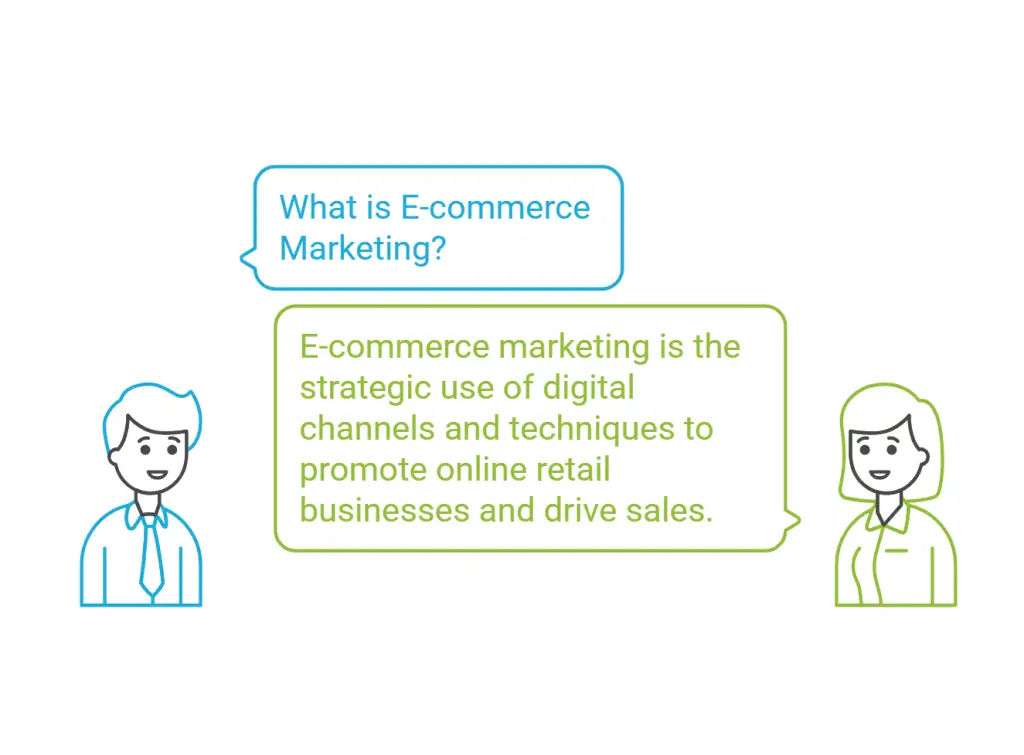
It encompasses a range of activities—from search engine optimization (SEO) and social media outreach to content creation, email campaigns, and paid advertising—all designed to attract and convert online visitors into loyal customers. At its core, e-commerce marketing is about building a strong digital presence that resonates with consumers, ensuring that every touchpoint—from the initial website visit to the final purchase—is engaging and persuasive.
By leveraging data-driven insights, businesses can tailor their marketing efforts to meet the unique needs of their target audiences. This means understanding consumer behavior, identifying trends, and continuously optimizing campaigns to improve performance. E-commerce marketing is not just about driving traffic; it’s about creating a seamless shopping experience that enhances brand perception and builds long-term customer relationships. Effective strategies in this realm help businesses stand out in a crowded digital marketplace and achieve sustainable growth.
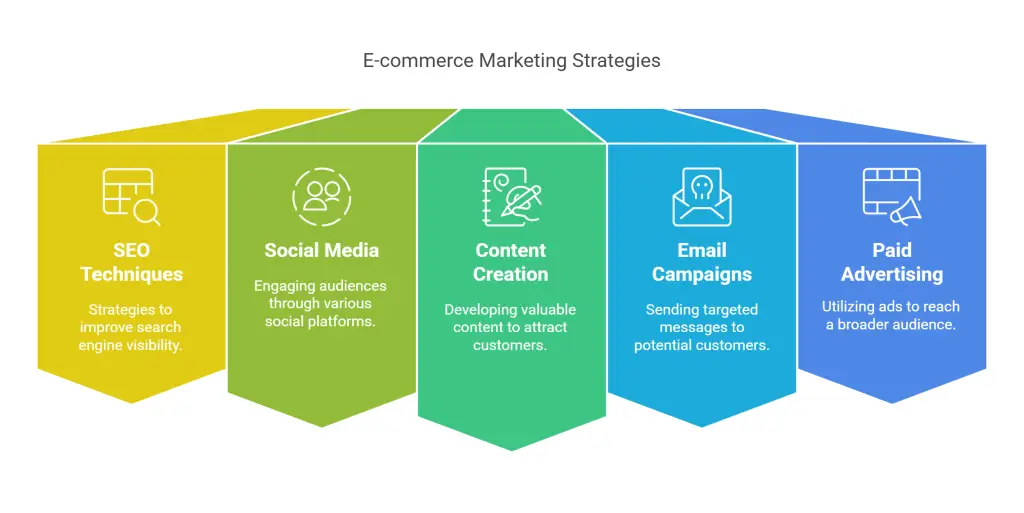
Understanding Your Target Audience
Before you can effectively market your e-commerce business, it’s vital to understand who your customers are and what they value. This knowledge allows you to tailor your branding and marketing strategies to meet their needs and preferences.
Identifying Your Ideal Customer
- Demographics: Analyze age, gender, income level, location, and education to create detailed customer profiles.
- Psychographics: Understand your customers’ interests, lifestyles, values, and pain points to connect on a deeper level.
- Behavioral Patterns: Examine shopping habits, product preferences, and online behavior to predict purchasing decisions.
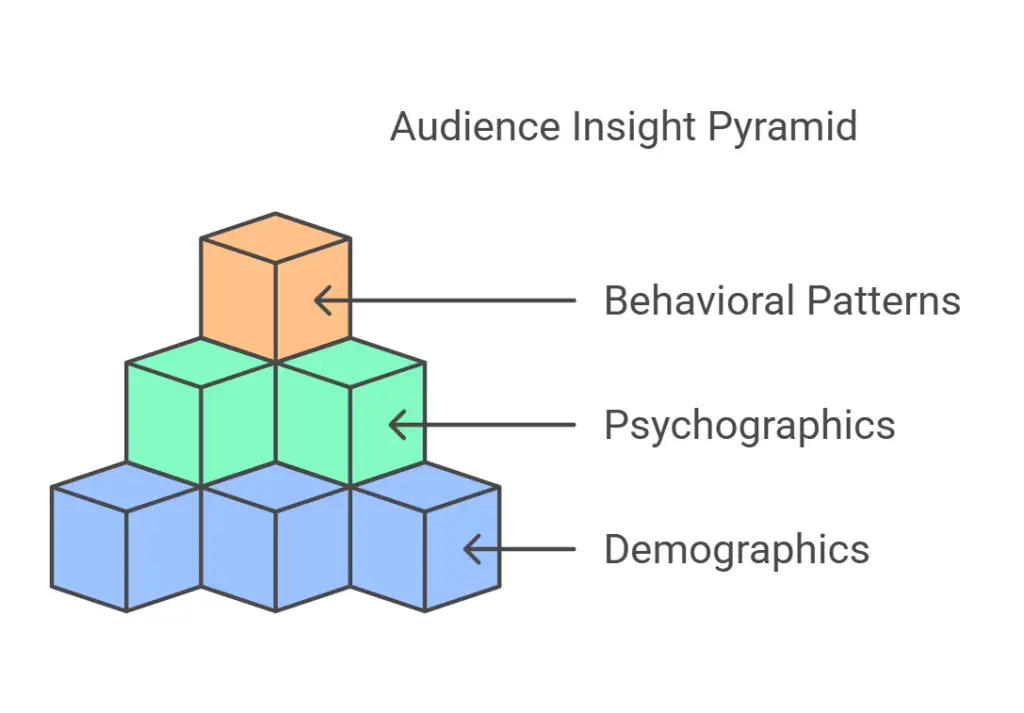
Tools for Audience Analysis
- Google Analytics: Provides insights into website traffic, user demographics, and behavior patterns.
- Social Media Analytics: Platforms like Facebook Insights and Instagram Analytics help track engagement and audience characteristics.
- Surveys and Feedback: Use tools like SurveyMonkey or Google Forms to gather direct input from your audience.
Crafting a Unique Value Proposition (UVP)
Your unique value proposition is a clear statement that explains how your product or service solves customers’ problems, what benefits they can expect, and why they should choose you over competitors.
Developing Your UVP
- Identify Core Benefits: Focus on the primary advantages your product offers and how it improves the customer’s life.
- Differentiate from Competitors: Highlight unique features or aspects that set your brand apart.
- Simplify Your Message: Ensure your UVP is concise, easily understood, and communicated across all marketing channels.
Examples of Effective UVPs
- Dollar Shave Club: “A great shave for a few bucks a month.”
- Warby Parker: “Eyewear with a purpose – affordable glasses that look great and do good.”
- TOMS: “With every pair you purchase, TOMS will give a pair of new shoes to a child in need. One for One.”
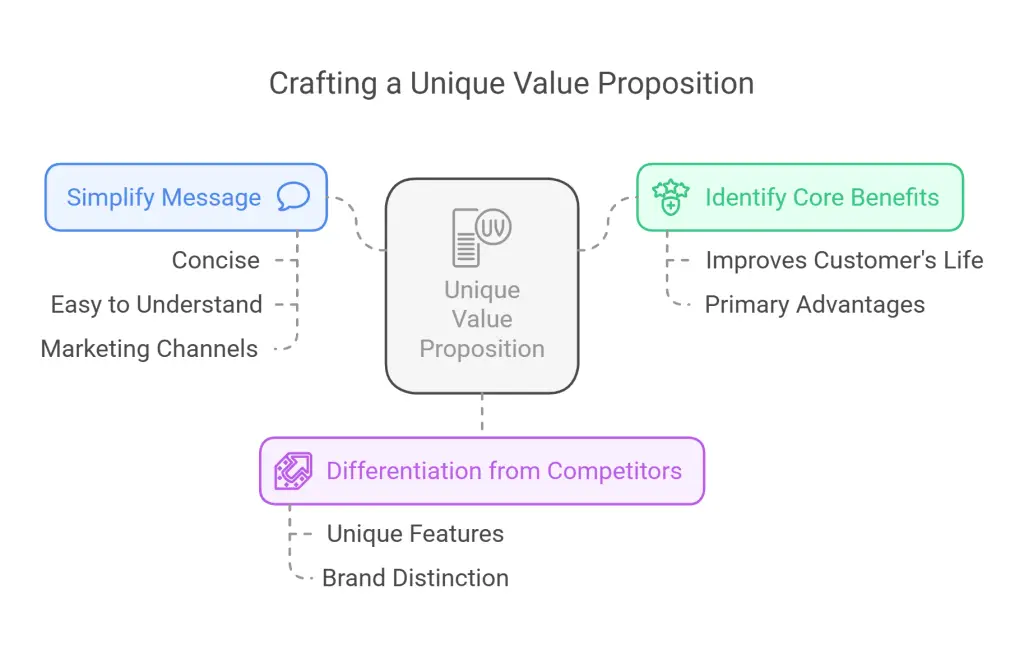
Building a Strong Brand Identity
A cohesive brand identity is essential for establishing trust and recognition with your audience. It encompasses everything from your logo and color scheme to your brand voice and messaging.
Elements of a Strong Brand Identity
- Logo and Visuals: Create a memorable logo and consistent visual elements that reflect your brand values and resonate with your audience.
- Brand Voice: Develop a distinctive tone and style for your communications, whether it’s friendly, professional, or humorous.
- Consistent Messaging: Ensure your brand message is clear and consistent across all platforms, from your website to social media.
Steps to Establishing Your Brand Identity
- Define Your Brand’s Mission and Values: Clearly articulate your brand’s purpose and the principles guiding your business.
- Create a Brand Style Guide: Document guidelines for your logo, colors, fonts, and messaging to maintain consistency.
- Engage Your Audience: Foster community and loyalty by encouraging interaction and feedback.
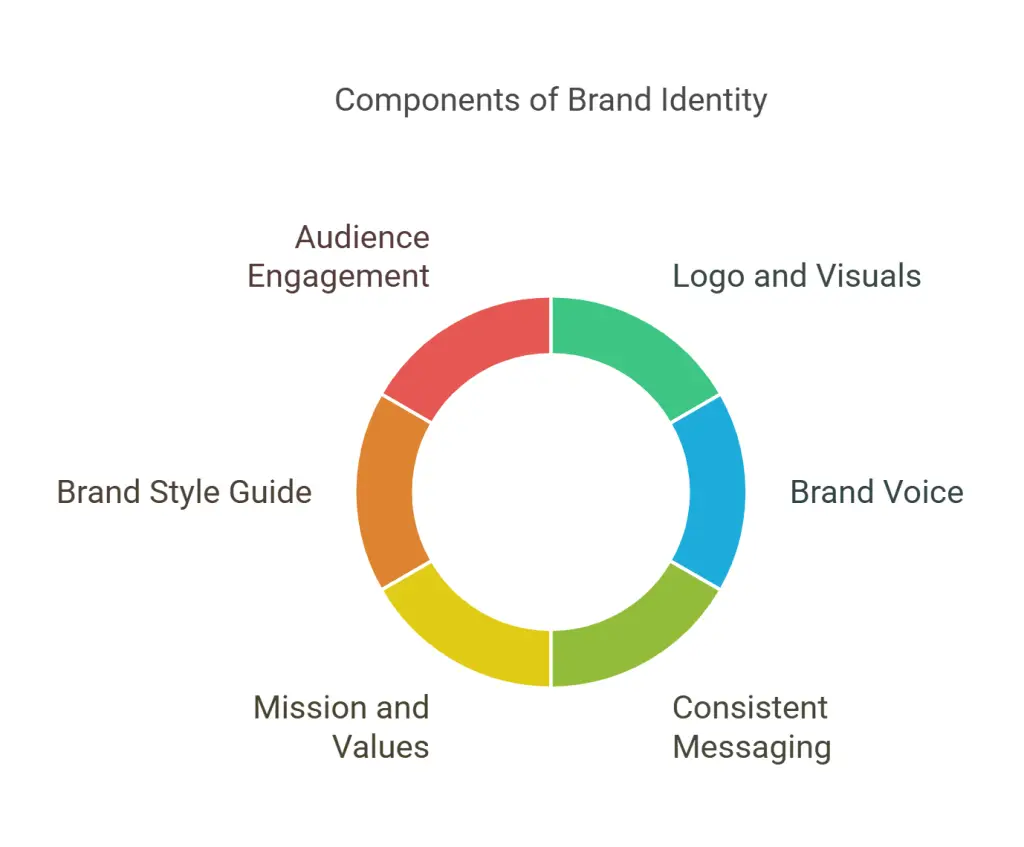
Leveraging Digital Marketing Channels
Digital marketing channels are crucial for reaching and engaging your target audience. Utilizing these platforms effectively can significantly enhance your brand’s visibility and influence. In today’s competitive business environment, where consumers are increasingly connected online, digital marketing provides businesses with a range of tools and strategies to capture attention and drive engagement. Here’s a comprehensive look at why these channels are indispensable for small businesses and how they can be strategically leveraged.
The Importance of Digital Marketing Channels
- Expanding Reach and Accessibility: Digital marketing channels break down geographical barriers, allowing businesses to reach a global audience. Unlike traditional marketing, which is often limited by physical location and higher costs, digital marketing offers the flexibility to connect with potential customers worldwide. This expanded reach means businesses can tap into new markets and demographics, enhancing their growth potential.
- Personalized and Targeted Messaging: One of the most powerful aspects of digital marketing is its ability to deliver personalized experiences. Through data analytics and customer insights, businesses can create tailored messages that resonate with specific audience segments. For instance, email marketing platforms allow for segmentation based on user behavior, preferences, and demographics, resulting in more relevant and impactful communication. Similarly, social media ads can be precisely targeted to reach users who are most likely to engage with your content or products.
- Cost-Effectiveness and Higher ROI: Digital marketing is often more cost-effective than traditional methods. Channels like social media, email, and content marketing allow businesses to reach large audiences without the high costs associated with print or broadcast advertising. Moreover, digital campaigns can be easily measured and optimized, ensuring that marketing budgets are used efficiently to achieve the highest possible return on investment (ROI). Pay-per-click (PPC) advertising, for example, allows businesses to set specific budgets and only pay when users interact with their ads, maximizing the value of their marketing spend.
- Building Brand Authority and Trust: Consistent and quality content creation through digital channels helps establish businesses as authorities in their fields. By sharing informative and valuable content, businesses can demonstrate expertise and build trust with their audience. Blogging, webinars, podcasts, and social media are excellent platforms for showcasing industry knowledge and providing solutions to customer pain points, positioning the brand as a trusted resource.
- Engagement and Community Building: Digital marketing enables direct interaction with customers, fostering a sense of community and belonging. Social media platforms are particularly effective for engaging with audiences, as they provide opportunities for real-time communication and feedback. Businesses can use these interactions to strengthen relationships, address customer concerns, and create a loyal following. Engaged communities are more likely to advocate for the brand, leading to increased word-of-mouth referrals and organic growth.
- Data-Driven Decision Making: The ability to collect and analyze data is one of the most significant advantages of digital marketing. Every interaction online generates data that can be used to refine marketing strategies and improve decision-making. Tools like Google Analytics, social media insights, and email marketing reports provide valuable information about customer behavior, campaign performance, and market trends. By leveraging these insights, businesses can make informed adjustments to their marketing efforts, ensuring that they remain effective and relevant.
- Agility and Adaptability: Digital marketing channels offer unparalleled flexibility, allowing businesses to quickly adapt to changes in the market or consumer behavior. Unlike traditional marketing, which can take time and resources to modify, digital campaigns can be adjusted in real time. Whether it’s tweaking ad copy, testing new content formats, or shifting budget allocations, digital marketing allows businesses to remain agile and responsive to new opportunities or challenges.
- Integration with Sales Processes: Digital marketing can seamlessly integrate with sales processes to create a cohesive customer journey. For example, marketing automation tools can nurture leads through personalized email sequences, guiding them from initial awareness to the decision-making stage. Social media and online chatbots can provide instant support and information, helping potential customers overcome objections and make informed purchases. This integration not only improves the customer experience but also increases the likelihood of conversions and sales.
- Staying Competitive: In an era where consumers are increasingly digital-savvy, businesses that fail to leverage digital marketing risk falling behind their competitors. Staying competitive requires adopting digital strategies that not only reach but engage and convert potential customers. Businesses that embrace digital marketing can position themselves as innovative leaders in their industry, attracting tech-savvy consumers and gaining a competitive edge.
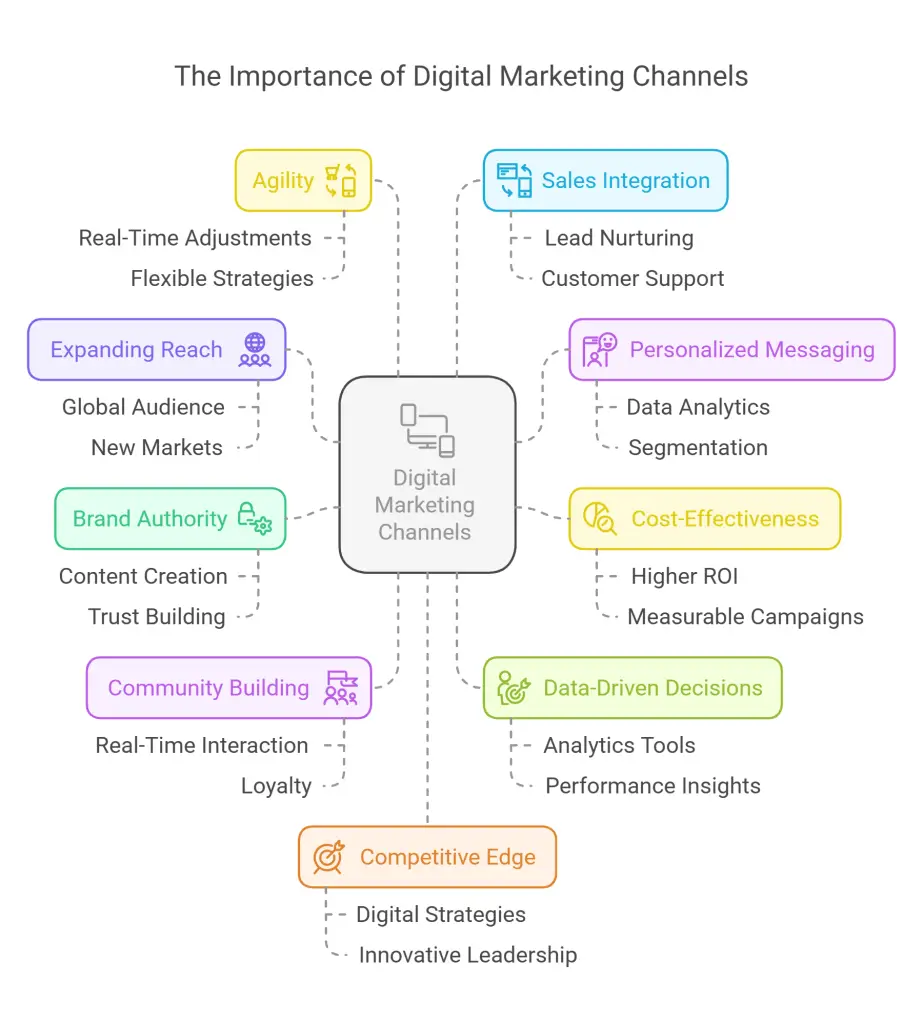
Types of Digital Marketing Channels
Social Media Marketing
- Platform Selection: Choose platforms that align with your target audience’s preferences (e.g., Instagram for visual products, LinkedIn for B2B).
- Content Strategy: Share a mix of promotional content, user-generated content, and educational posts to keep your audience engaged.
- Influencer Partnerships: Collaborate with influencers who align with your brand values to extend your reach and credibility.
Email Marketing
- Build a Subscriber List: Encourage sign-ups through website pop-ups, exclusive offers, and engaging content.
- Segment Your Audience: Customize email campaigns based on customer behavior, interests, and demographics for better engagement.
- Personalization: Use personalized subject lines and content to increase open rates and conversions.
Search Engine Optimization (SEO)
- Keyword Research: Identify relevant keywords that your audience is searching for and integrate them into your website content.
- On-Page Optimization: Ensure your website is optimized for search engines with proper meta tags, headings, and internal links.
- Content Marketing: Create valuable, informative content that addresses your audience’s needs and encourages sharing.
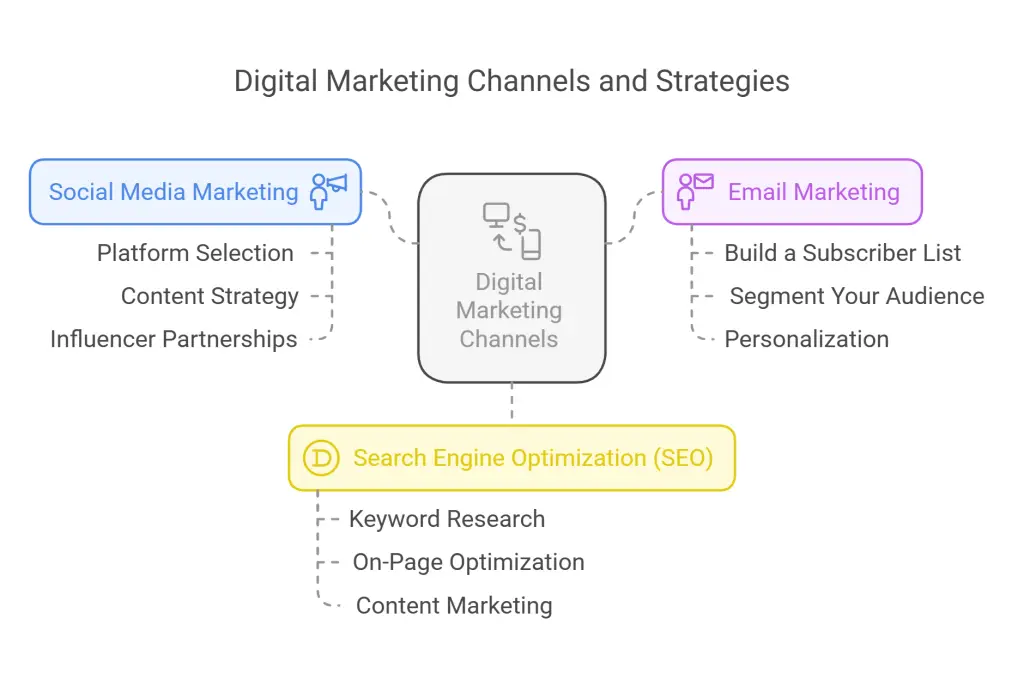
Maintaining a Positive Online Reputation
Your online reputation can significantly impact your brand’s success. Managing reviews, social media interactions and customer feedback is essential for building trust and loyalty.
Strategies for Reputation Management
- Monitor Online Mentions: Use tools like Google Alerts and Mention to track your brand’s mentions and address issues promptly.
- Encourage Positive Reviews: Request feedback from satisfied customers and showcase testimonials on your website and social media.
- Respond to Negative Feedback: Address complaints professionally and promptly to demonstrate your commitment to customer satisfaction.
Building Trust and Credibility
- Transparency: Be open about your business practices, product sourcing, and policies to build trust with your audience.
- Consistent Quality: Ensure your products and services consistently meet or exceed customer expectations.
- Community Engagement: Foster relationships with your audience by participating in online discussions and supporting social causes.
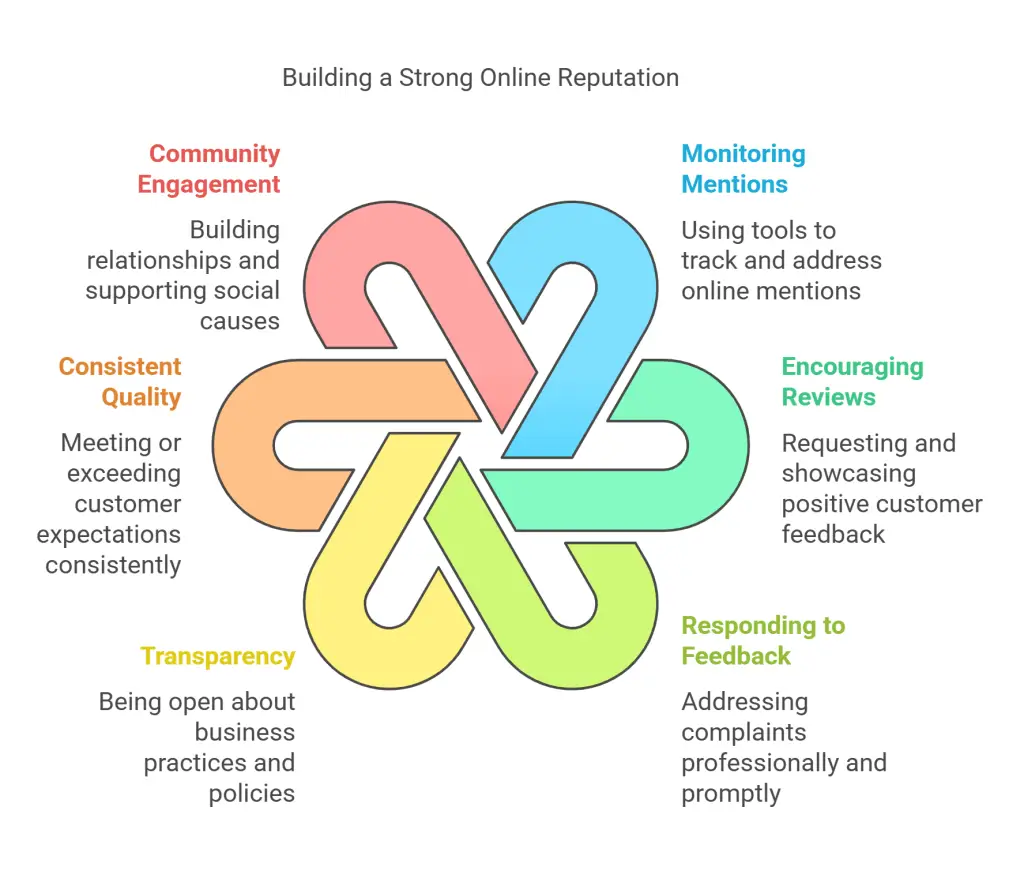
Case Study 1: Petal & Parchment
Background:
Petal & Parchment, a boutique stationery and floral shop founded by Mia Carter, redefined personalized gifting in a small town by combining handcrafted paper goods with bespoke floral arrangements.

Challenges:
Breaking into a niche market with limited resources while competing with mass-produced alternatives.
Strategies:
- Community Engagement: Mia built a loyal customer base by hosting DIY workshops and sharing behind-the-scenes content on social media.
- Personalized Offerings: The business offered custom stationery and floral pairings for weddings, events, and everyday gifts, setting it apart from generic competitors.
- Local Partnerships: Petal & Parchment collaborated with nearby bakeries and event planners to create bundled packages, driving referrals and word-of-mouth growth.
Outcomes:
The shop grew from a home-run operation to a thriving storefront, expanding its product line and becoming a go-to local brand for customized gifts.
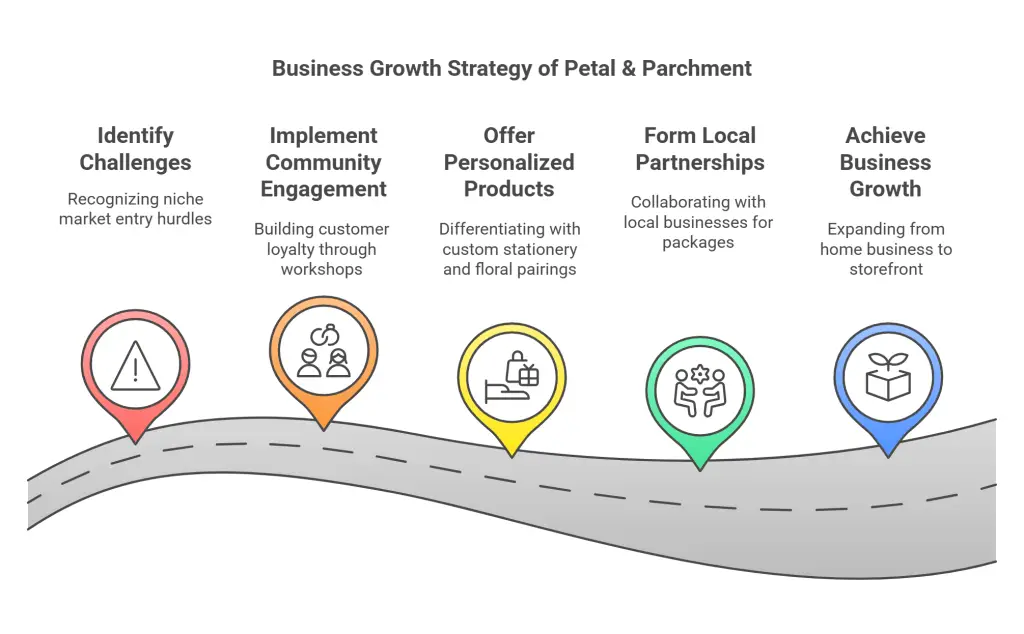
Case Study 2: Timber & Roast
Background:
Timber & Roast, a specialty coffee and handcrafted furniture shop founded by Daniel and Ava Simmons, combined two passions—artisan coffee and woodworking—under one roof in a small town.

Challenges:
Differentiating from chain coffee shops and furniture retailers while building a brand from scratch.
Strategies:
- Sustainability Focus: The couple sourced reclaimed wood for their furniture and ethically sourced coffee beans, attracting eco-conscious consumers.
- Experiential Retail: Customers could enjoy a fresh brew while browsing handcrafted tables and shelves, turning shopping into an immersive experience.
- Story-Driven Marketing: Timber & Roast shared the process behind each piece of furniture and coffee origin stories, making customers feel connected to the products.
Outcomes:
The shop became a local favorite, drawing in customers from neighboring towns and expanding to offer online furniture sales and a subscription coffee service.
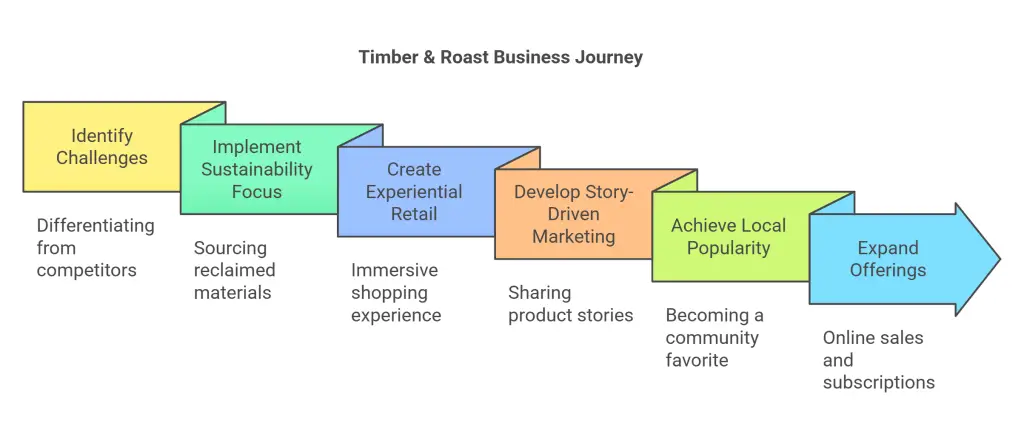
Overcoming Challenges in E-commerce Branding
Building a successful e-commerce brand comes with its own set of challenges. Understanding and addressing these obstacles is crucial for sustainable growth.
Common Challenges
- Intense Competition: Standing out in a crowded market requires differentiation and innovative marketing strategies.
- Changing Consumer Preferences: Staying attuned to evolving customer needs and trends is essential for relevance.
- Maintaining Consistency: Ensuring consistent branding and messaging across all channels can be challenging but is vital for credibility.
Solutions and Strategies
- Continuous Market Research: Regularly analyze market trends and consumer behavior to adapt your strategies.
- Agility and Adaptability: Be flexible and open to change, allowing your brand to pivot in response to new opportunities.
- Invest in Customer Experience: Focus on delivering exceptional customer service and a seamless shopping experience.
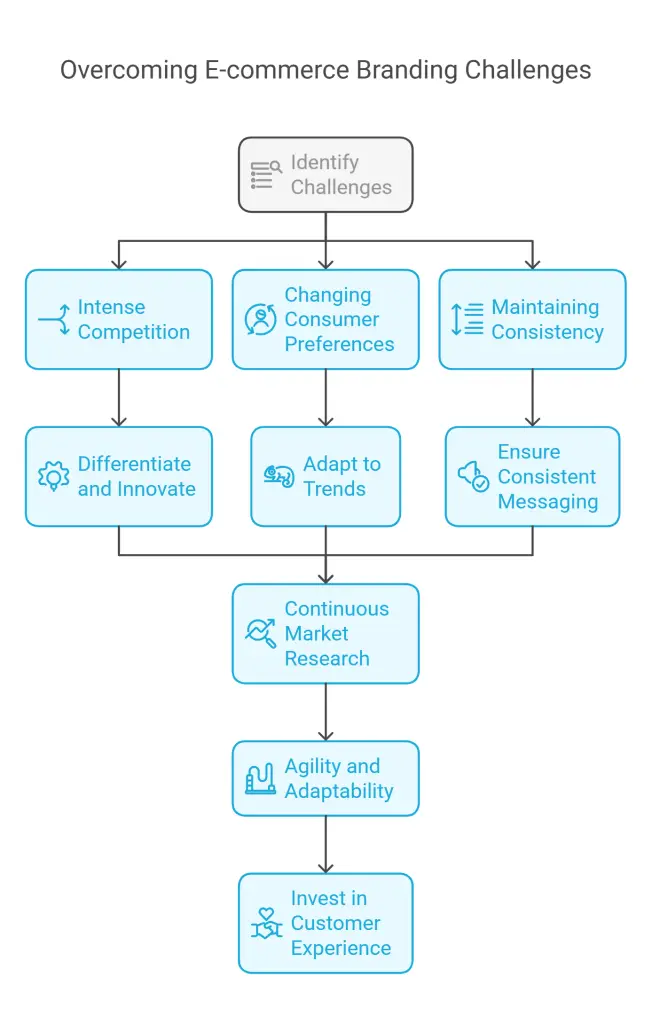
Conclusion
Building a strong brand and positioning your e-commerce business for success requires a strategic approach and a deep understanding of your audience. By crafting a unique value proposition, establishing a cohesive brand identity, leveraging digital marketing channels, and maintaining a positive online reputation, you can create a powerful brand that resonates with customers and drives growth.
Remember, successful branding is not a one-time effort but an ongoing process that requires dedication, creativity, and a commitment to delivering value. Stay informed about industry trends, continuously refine your strategies, and always prioritize your customers’ needs. By doing so, you’ll be well-equipped to navigate the challenges of the e-commerce landscape and achieve long-term success.
Further reading
BigCommerce Australia. “Ecommerce Marketing.” Last accessed February 5, 2025. https://www.bigcommerce.com.au/articles/ecommerce/ecommerce-marketing/.
Spiceworks. “What Is Ecommerce Marketing?” Last accessed February 5, 2025. https://www.spiceworks.com/marketing/ecommerce/articles/what-is-ecommerce-marketing/.
HubSpot. “Ecommerce Marketing.” Last accessed February 5, 2025. https://blog.hubspot.com/marketing/ecommerce-marketing.
YouTube. “Ecommerce Marketing Explained.” Last accessed February 5, 2025. https://www.youtube.com/watch?v=46IXZFV4_tw.
YouTube. “Ecommerce Marketing Strategies.” Last accessed February 5, 2025. https://www.youtube.com/watch?v=R0sovkI9kF0.
Vividads. “Top 16 Marketing Strategies for E-commerce in Australia.” Last accessed February 5, 2025. https://www.vividads.com.au/blogs/marketing/top-16-marketing-strategies-for-e-commerce-in-australia.
Amazon Sell. “Ecommerce Marketing.” Last accessed February 5, 2025. https://sell.amazon.com/learn/ecommerce-marketing.
Maropost. “Everything You Need to Know About E-commerce Marketing.” Last accessed February 5, 2025. https://www.maropost.com/blog/everything-you-need-to-know-about-e-commerce-marketing/.


